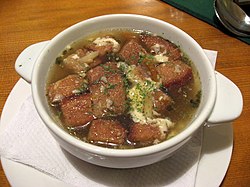

Garlic soup is a type of soup using garlic as a main ingredient. In Spanish cuisine, sopa de ajo ('soup of garlic') is a traditional garlic soup made with bread and egg [1] poached in chicken broth, and laced with garlic [2] and sherry.


Garlic soup is a type of soup using garlic as a main ingredient. In Spanish cuisine, sopa de ajo ('soup of garlic') is a traditional garlic soup made with bread and egg [1] poached in chicken broth, and laced with garlic [2] and sherry.

In the Czech Republic, garlic soup is called česnečka. [3] It is made with garlic and potatoes and topped with fried bread. [4] Sometimes cheese, ham or eggs are added.[ citation needed ]
Versions of garlic soup have been prepared in Provence, France. [5] [6]
Versions of garlic soup similar to Spanish versions are prepared in Mexico. [2]
In Poland, garlic soup is sometimes called zupa na gwoździu (literally soup on the nail ). [7]
In Upper Silesia, the traditional wodzionka soup has a garlic-based version, made with diced garlic, hard-boiled egg, potatoes and fried bread.

In Spain, egg whites are sometimes whipped into the soup, as with egg drop soup. Sopa de ajo [8] is a traditional winter soup in Palencia and Valladolid where it is made with bread mixed with paprika, water and garlic. It is cooked slowly until the desired degree of thickness, and a raw egg is sometimes whipped into the soup as it is served. Sopa de ajo is also traditional in Castilian-Leonese cuisine and Castilian-Manchego cuisine. In Extremaduran cuisine, sopa blanca de ajos (white bean garlic soup) is a tradition.[ citation needed ]